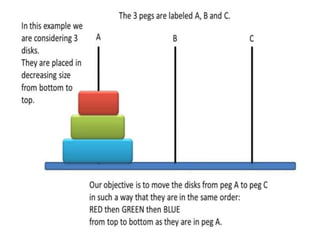The document provides a comprehensive overview of data structures, covering definitions, classifications, and operations associated with both primitive and non-primitive data structures. It explains the significance of organizing data efficiently, details various algorithms such as recursion andmemory management techniques, and highlights example implementations in C programming. The document serves as an educational resource aimed at computer science students to understand fundamental concepts related to data structures.

![Data
Data are simply collection of facts and figures. Data are
values or set of values.
Data Item
A data item refers to a single unit of values. Data items
that are divided into sub items are group items; those
that are not are called elementary items.
• For example, a student’s name may be divided into
three sub items – [first name, middle name and last
name] but the ID of a student would normally be
treated as a single item. In the above example ( ID,
Age, Gender, First, Middle, Last, Street, Area ) are
elementary data items, whereas (Name, Address ) are
group data items.](https://image.slidesharecdn.com/ds-240514043334-5a32fa84/85/Data-Structure-Introduction-for-Beginners-2-320.jpg)













![Select: Accessing of data with in a data structure.
Example: printf(“%d”,a[5]);
The array element a[5] is selected for printing.
Update: - change data or modify the data in a data
structure
For example,
int x=3; // declaration and initialization of x
.
.
x=10; // Assignment statement
Here, initially value 3 is assigned to x. Later value 10 is
assigned to x. This modifies the value of x from 3 to 10.
Consider x=x+5; This expression x=x+5
modifies 10, to the new value 15.](https://image.slidesharecdn.com/ds-240514043334-5a32fa84/85/Data-Structure-Introduction-for-Beginners-16-320.jpg)








































![Memory allocation is the process of setting aside sections
of memory in a program to be used to store variables, and
instances of structures and classes.
Memory allocation has two core types;
Static Memory Allocation: The program is allocated
memory at compile time.
Static memory allocation means we reserve a certain amount
of memory by default, inside our program to use for
variables. It is fixed in size. It need not grow or shrink in
size.
The standard method of creating an array of 10 integers on
the stack is:
int arr[10];
This means 10 memory locations are allocated to hold 10
integers. Memory is said to be allocated statically.](https://image.slidesharecdn.com/ds-240514043334-5a32fa84/85/Data-Structure-Introduction-for-Beginners-57-320.jpg)








